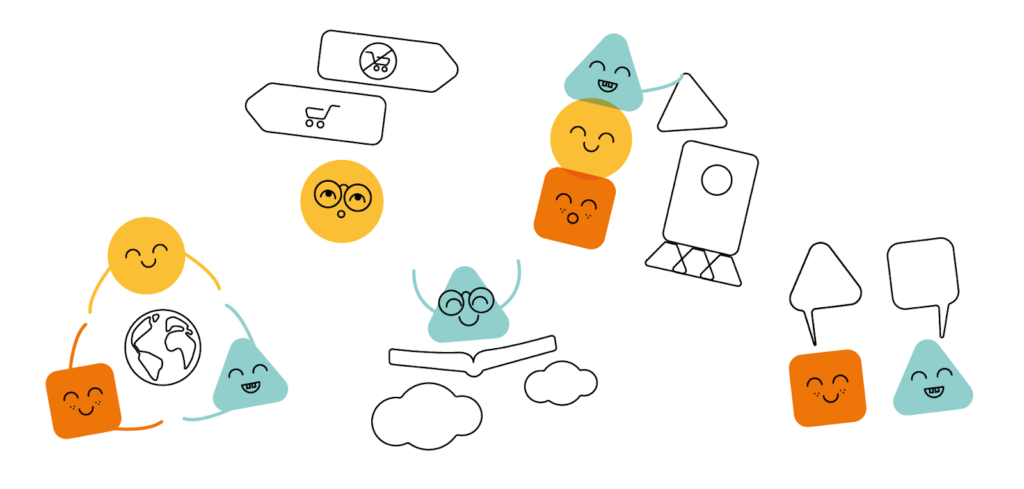When we design for children, we design both for the present and for the future. Childhood experiences have an impact on children, which translates into long-term effects on the population and society—our collective future. Excluding children from our thinking is a systemic bias and we work to change that.

Designing for Children’s Rights (D4CR) is a global non-profit association, working in collaboration with UNICEF to create awareness about the importance of keeping children’s rights in mind when building products and services. We continuously work to develop the Designing for Children’s Rights Guide – 10 design principles which instead of pointing out what is wrong, guides how to do things right.
We are now happy and proud to present a brand new, updated version of the guide. For this new version, we especially considered the U.N. General comment No. 25 (2021) on children’s rights in relation to the digital environment. It strongly encourages businesses to take measures to innovate in the best interests of the child and to maintain high standards of transparency and accountability.
Children use a wide range of existing services and products. And they face the indirect effects of using services and products that are not designed with the consideration of the needs or rights of the child, and do not include children as stakeholders by default. To ensure the well-being of children, it is especially important to ensure the best interest of the child in design and business decisions. So, where can designers find guidance and build knowledge to take on this important challenge? This question was the starting point for the D4CR design guide work.
The D4CR community consists of an amazing mix of designers, researchers, neuroscientists, psychologists, psychiatrists, educational scientists, experts on child rights, and other professionals who share a passion for creating and setting new standards for designing products for children and adolescents.
We all meet and work together at global Talkoot events – a Finnish tradition where the community is invited to help create something bigger than one person could have managed on their own. This is how the first version of the design guide was born in Helsinki 2018, at a Talkoot co-hosted by UNICEF. We are also organized locally in local chapters all around the world.
The purpose of the design guide is to be an actionable go-to resource for both new and experienced designers, as well as anyone making business decisions that might affect children. We want it to be both a source of knowledge and a tool for reflection. To make the guide more accessible, we have now grouped the principles into three overarching themes: inclusion, play & learning, and safety & sustainability, and we have added an extensive list of high-quality resources for learning more about these topics. We also added a brand new principle called Design for future, addressing children’s right to a thriving planet for the generations to come and the importance of sustainable design.
Our principles were originally written with a fictive child’s voice. For the update, we wanted the voice of the guide to be from experts to experts, and added children’s perspectives as quotes, collected by the D4CR community. We felt this update kept us better in line with the first principle of the guide highlighting the importance of designing not only for children, but also with them:
|
Principle 1: Gather and respect children’s views
Drawn from the UN Rights of the Child: The Right to Development and The Right to Participate |
We encourage you to read all the principles, make them your own and use them in a way that fits your project or organization. As the world around us changes, the design guide will need to evolve and change too. So, please share your experiences with the guide with us. Let’s make the world a better place – together.
Follow the links below to learn more about each principle, and join us in designing for children’s rights!
|
The 10 Principles for Designing for Children’s Rights Design for Inclusion
Design for Play & Learning
Design for Safety & Sustainability |
 Chris Lindgren is a Kids’ UX Designer & Researcher, always bringing children’s perspectives into the design process. She spent eight years making kids’ apps at the award-winning play studio Toca Boca and is now pursuing her mission in her own company. She has worked with D4CR since its start in 2018 and is a board member of the D4CR association.
Chris Lindgren is a Kids’ UX Designer & Researcher, always bringing children’s perspectives into the design process. She spent eight years making kids’ apps at the award-winning play studio Toca Boca and is now pursuing her mission in her own company. She has worked with D4CR since its start in 2018 and is a board member of the D4CR association.
 Jonna Tötterman is a Director of Strategic Insights, leading a management consultants team at Vincit. She is driven to make a positive change to this world, and help organizations to reach their environmental and social sustainability transformations. She is also a co-founder and board member of Designing for Children’s Rights and has worked with D4CR topic since 2017.
Jonna Tötterman is a Director of Strategic Insights, leading a management consultants team at Vincit. She is driven to make a positive change to this world, and help organizations to reach their environmental and social sustainability transformations. She is also a co-founder and board member of Designing for Children’s Rights and has worked with D4CR topic since 2017.
 Petter Karlsson is a Play Designer at Toca Boca with a deep interest in play and making the world at least a little bit better. After joining Toca Boca in 2015 he has been creating playful experiences for children all over the world with the Toca Life World. He also has a special focus on improving diversity and inclusion in the studio’s games. He has worked with D4CR since its start in 2018.
Petter Karlsson is a Play Designer at Toca Boca with a deep interest in play and making the world at least a little bit better. After joining Toca Boca in 2015 he has been creating playful experiences for children all over the world with the Toca Life World. He also has a special focus on improving diversity and inclusion in the studio’s games. He has worked with D4CR since its start in 2018.
Illustrations by: Alona Lazarenko


